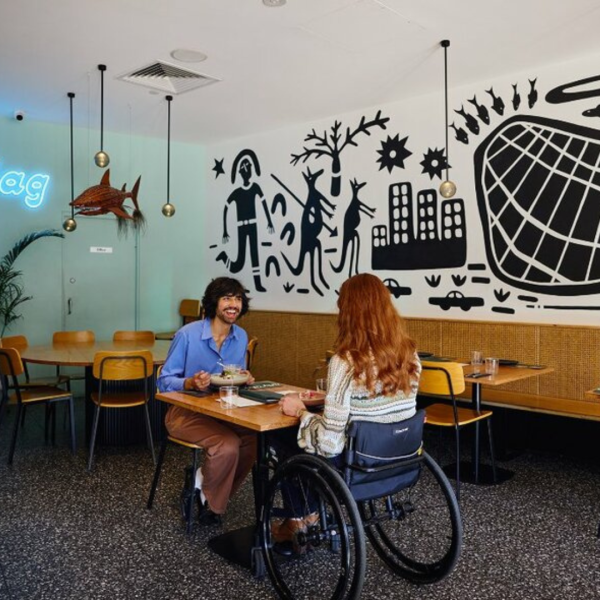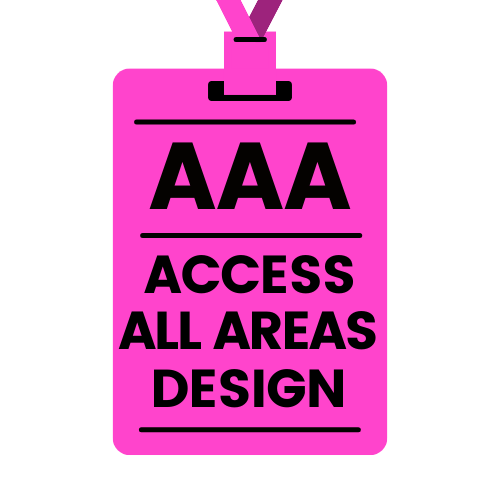MELBOURNE’S BEST ACCESSIBLE ABORIGINAL EXPERIENCES

Be immersed in the history and modern culture of the Kulin Nation with experiences and guided Aboriginal tours right in the heart of Naarm (Melbourne). Hear stories, taste food, and gain insight into the extraordinary legacy of Australia’s First Peoples. Best of all, these unique inner-city experiences of Australia’s First Peoples are disability-friendly and welcoming to all.
Koorie Heritage Trust
Located by the banks of the Birrarung Marr (River of Mists) in the cultural heart of Narrm (Melbourne) lies the Koorie Heritage Trust. A First Peoples arts and cultural organisation, it celebrates Victorian First Peoples art and artists through exhibitions and public programs. The permanent collections include artefacts, photographs, and oral history recordings. Touring exhibitions support and promote contemporary works.
The building itself allows you to understand and connect to Country through its design and fitout: the red reflects the landscape; the columns are a reimagining of the scar tree; the rippled ceiling echoes the movement of water. Its award-winning design, led by indigenous architects, is an integral part of the experience.
And, it’s all accessible. Stairs, an escalator or a lift transports you to all three levels. Accessible toilets djilawa (toilets) are on each level too. Light-filled, there’s lots of space to move around. The KHT gift shop is very close by and has an auto-entry door and lots of room. The Birrarung Wilam (River Camp) guided walking tour along the river is wheelchair accessible. Just let your guide know that you prefer a ramp to stairs. Flinders Street Station is across the road, and accessible platform super stops are on St Kilda Road.
Aboriginal Heritage Walk
Want to learn how Australia’s native plants have been used for food and medicine? The Aboriginal Heritage Walk at the Royal Botanic Gardens is the ideal tour. You’ll discover why the Kulin Nation considers the Gardens an important cultural site. And gain insight into the rich history and thriving culture of Australia’s First Peoples.
Led by a First Nations guide, the tour is wheelchair accessible. Companion cards and cardholders can participate in any walks for free when they are accompanying a client. There are accessible toilets throughout the gardens including a Changing Places facility near the Visitor Centre. Seating is along the paths and on some of the grassed areas. An interactive map helps with preparing for your visit. Several streets around the Gardens offer accessible parking spots. The closest accessible platform stops are on St Kilda Road.
Birrarung Wilam + William Barak Bridge
Birrarung Wilam is a phrase from the Woiwurrung language of the Wurundjeri people meaning ‘river camp’. Part of the Birrarung Marr public park along the north bank of the Yarra River, it is an art installation that serves as a place for education, reflection, and connection. The central part of the work is the mound campsite, a modern version of a sitting place. It includes an eel pathway, message sticks, and a group of ancestor stones.
Serving as a link between Birrarung Wilam and Melbourne’s sporting precinct is the William Barak Bridge. This pedestrian and cyclist bridge, named after a significant Wurundjeri Woiwurrung elder, spans the railyards below and provides uninterrupted views of the Melbourne skyline. More than just a crossing point, the bridge offers an immersive cultural experience through a sound installation. Playing voices of local Wurundjeri people, the soundscape changes as you travel across the bridge.
You can access Birrarung Wilam via Flinders Street near Fed Square. A flat wide path with a gentle slope leads you to the area. There are bench seats at various intervals along the path. The large rocks near the eel pathway are a seating option too. A slightly steeper path leads to the William Barak Bridge from Birrarung Wilam. You can also get there via lift or the Treetop Walk from Batman Avenue. The bridge is wide and flat and there are bench seats on it. Accessible platform super stops are on Flinders Street or St Kilda Road.

Indigenous Art from the NGV Collection
Drawings, photos, sculptures, videos, artefacts made of bark and more. The NGV Indigenous Collection honours and charts the evolution of aboriginal art. See Rover Thomas’s unique works made with earth pigments. Destiny Deacon’s iconic photographs are unmissable, as is Anwerlarr anganenty (Big Yam Dreaming) by Emily Kam Kngwarray.
Sharing the work of First Nations artists is ongoing exhibition Wurrdha Marra. Meaning ‘many mobs’ in Wurundjeri Woiwurrung language, it features art from emerging to senior figures, across time and place. Familiar works are displayed alongside new acquisitions including Brook Andrew’s neon sign. Maree Clarke’s glass eel trap. And Kaylene Whiskey’s paintings of strong female figures, including Wonder Woman, Dolly Parton and Tina Turner, in desert landscapes.
Open until 4 August, My Country: Country Road + NGV First Nations Commissions features new works by emerging First Nations artists. Working in collaboration with mentors these pieces are the artists’ most ambitious works to date.
The Ian Potter Centre, NGV Australia is in Fed Square and is fully accessible. There’s lift access to each floor and accessible toilets on each one. Assistance animals are welcome and there are resources for visitors with sensory sensitivities. Paid accessible parking is available at Fed Square. Flinders Street Station and accessible platform super stops are nearby.
Big Esso by Mabu Mabu
Crocodile tongue skewer. Emu steak with macadamia. Mushroom parfait with pickled persimmon. Big Esso, inspired by the Torres Strait and Australia’s tropical north, celebrates food with native ingredients. The drinks menu also honours modern Indigenous culture. It features an all-Australian menu of producers and First Nations distillers who champion local botanicals. The cocktail list includes drinks like the Margarita with lemon myrtle and tamarind, and the whisky fizz with ooray plum shrub.
The casual diner has a step-free wide entry. It is light-filled and has lots of room between tables. Seating choices include a bench along the wall and chairs at tables that are a good height for wheelchairs. Or sit on stools at one of the higher tables. You can dine outside too, at long tables and benches under umbrellas. Accessible toilets are just outside in the foyer of the Yarra Building. A staff member can direct you to where they are. Located in Fed Square, Flinders Street Station and accessible platform super stops are on St Kilda Road.
Bunjilaka Aboriginal Cultural Centre, Melbourne Museum
Have you ever seen an eel eat? Heard the 38 distinct languages of Victoria? Or thought about what it means to connect to Country? Experience all this and more at Bunjilaka Aboriginal Cultural Centre. Celebrating indigenous culture through performances, artwork, and nature, the Centre sits within Melbourne Museum.
In the First Peoples exhibition, enter Bunjil’s nest, the wedge-tailed eagle and ancestral spirit, and hear how he sang the Country, Law and people of the Kulin nation into being. Explore the Milarri Garden Trail and learn about the traditional uses of indigenous plants. See Piinpi, a new exhibition on until November, showcasing contemporary indigenous fashion by leading First Nations creatives.
From the exhibitions to the building, it’s all accessible. There are ramps throughout the Forest Gallery and Milarri Gardens and lifts to every level. Accessible toilets are on every level too. Free Auslan tours are available as are low-sensory sessions. Social scripts can be downloaded to help you plan your visit. Accessible platform super stops are on Nicholson Street and some accessible parking spots are in the car park.
